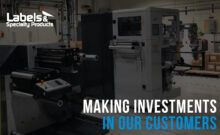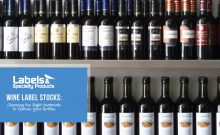How to Design Traditional Paper Wine Labels for the Modern Consumer
Across all markets, packaging design follows codes—milk products use white and blue colors, products for men use metallic squared forms, handmade products use a hand-script typeface, and wine bottles use white estate stock labels.
Paper facestock has an ongoing connection to wine bottles that’s lasted for centuries. While film labels often outperform against the elements, paper labels represent the classic look that consumers associate with a long tradition of winemaking. Of course, as the wine consumer changes, so too must the label.
Here are some ways wineries are modernizing their design of the paper label.
Modern Trends for Paper Wine Labels
Bright and Bold Colors
You’re not likely to find a Bordeaux Grand Crus label without white, black, red, and gold. The traditional colors communicate luxury, social distinction, elegance and tradition. While a classic paper wine label offers certain guarantees of quality, it doesn’t provide much more than that.
Wine brands now compete on-shelf to appear visually exciting. This has driven creatives to break some rules while retaining traditional materials. The Dieline highlights Bokeh Wine’s use of circular gradients, bold colors and metallic foil to showcase this new minimalist elegance.
Unique Stories, Not Clichés
French wines are classified by region, each with strict rules required to earn the right to display that title. That’s why the wine’s name, and chateau or vineyard, are central on labels from France.
However, what began in earnest is now a universal motif. Gothic and Germanic-style fonts and chateaux on wines outside of France can add an air of sophistication. But younger wine drinkers are searching for labels that tell a more unique story.
Modern wine label designers are forgoing the coat of arms for a specific narrative. For example, Australian-based Versions Wine designed each label to include an identical set of words. Different sections are redacted to give each varietal a unique story. The label’s vibrant reds, yellows and blues also reference the colors of their Australian landscape, which make it both identifiable and memorable.
Highly Texturized Finishes
While experienced oenophiles will likely search for the marks of tradition and region, newer wine drinkers need a bottle to “pop” off the shelf.
Brands such as Limnos Wine’s Krama take this literally. Texturized black and blue stripes on its label pay homage to its vineyards and their dark-colored grapes. Like acres of farmland from the birds-eye view of an airplane, the raised lines offer the story of its vineyards. It’s also a reason to touch, feel, and pull the bottle off the shelf.
Textured finishing details can also make you look twice. For example, Lanzerac Wine’s use of luxury textured paper stock, blind embossing, and cleverly-placed shadows create an optical illusion worth looking at more closely.
Augmented Reality
Augmented reality (AR) wine labels make products live and breathe. The app-based entertainment uses fun storytelling scenes—a trigger to entice consumers to try wines for the first time.
One of the most successful AR wine label apps comes from Australian brand 19 Crimes. When consumers hold the 19 Crimes app up to the bottles’ labels, they’ll see interview-style monologues. Banished to Australia, real-life criminals from 18th century Britain tell their stories.
Brands can also convince consumers to buy a bottle of wine by incorporating themselves into a broader social movement or societal trend using AR. In August 2018, the emBrazen Wines brand launched at the same time as the #MeToo movement and included famous historical women telling their stories.
Wineries must work with an app-development company to create an app in addition to designing a label that works with facial-recognition technology. Digital printing companies can make AR wine labels a reality through the printing of uniquely scannable images.
Find a Printer That Values Tradition and Trends
Your printer should recognize the past without getting stuck there. Labels & Specialty Products offers both flexographic and digital printing to meet your specific project and budgetary needs as you work to modernize your paper wine labels.
Contact our experts today to talk about your wine label printing project or other packaging needs.


